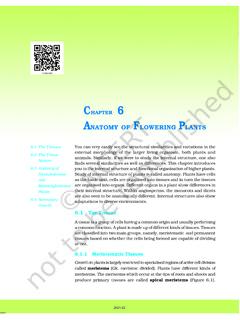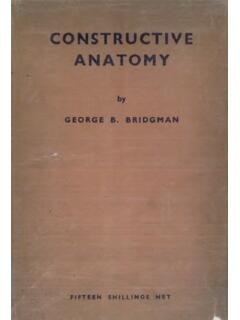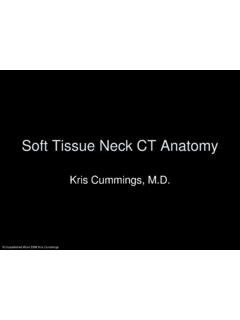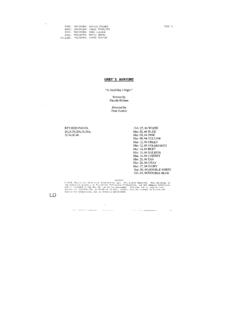Transcription of Kaplan Anatomy Coloring Book - California State University ...
1 ChapterOne:IntroductionANATOMICALPOSITIO NANDTERMS )(1)I, \ )..lII('---:-----':----;-~. isimportantto place describedas thebodyfacing you, feetplacedtogetherandflat on the helderect,armsstraightby the sidewithpalms thebodyaremadeas if thebodyisin thispositionsowhenyoudescribesomethingas beingabovesomethingelse it is alwayswithrespectto relativepositionof thepartsofthehumanbodyhas to themidlinewhilelateralmeans to the to thefrontwhileposterioror dorsalis to the near thesurfacewhiledeepmeansto the core of the the limbs,proximalmeanscloser to thetrunkwhiledistalis to the ends of the spacesprovidedandcolor in fourleggedanimals.~V? )~ =~..\!AnswerKey: a. Superior, b. Inferior, , d. Medial, e. Proximal, , ,h Posterior, , ,k. VentralANATOMICALPLANESOFTHEBODYM anyspecimensinanatomyaresectionedsothatt heinteriorof theorganor region can thecut isknownsothattheproperorientationof verydifferentif it is cut along horizontalcut isknownas atransversesectionor cutthatdivides thebodyor anorganintoanteriorandposteriorpartsis andrightpartsis thebodyisdivideddirectlydownthemiddlethe sectionisknownas midsagittalsectionisusually reserved fordividingthebodyintoto equal left anorgan(such as the eye) issectionedintotwoequalpartssuchthatther eis a left andrighthalfthenthis isknownas theillustrationsand color OneImKAPeLAN(I : a.
2 Frontal(coronal)plane,b. Transverse(cross-section)plane, (midsagittal) THEABDOMENI nanatomytheabdomenis dividedinto nine regions. Write the names ofthe regions in the left and righthypochondriacregions in light "below thecartilage." Thecommonuse of theword(someonewhothinksthey aresick all the time) reflects the Greekorigin of the word as theancientGreeksconsideredthe region to bethe center of thehypochondriacregions are thelumbarorlateralabdominalregions. These arecommonlyknownas the "love handles." Use yellow forthese regions. Below thelumbarregions are theinguinalor iliacregions. Youshouldcolor in theseregions with the same shade ofgreen. In themiddleof theabdomenis this region in red. Above thisis theepigastricregion(epi=aboveandgastric= stomach).Color thisregion theumbilical region is thehypogastricregion(hypo=below).Colorth isregion in clinical settings aquadrantapproachis used.
3 Write the names ofthe regions(rightupperquadrant,leftupperquad rant,rightlowerquadrant,leftlowerquadran t)inthe different Key: aRighthypochondriac, (lateral abdominal), , , , ,g. Left lumbar (lateral abdominal),h. Left inguinal oriliac, ,) Left upperquadrant, , lower quadrant, OneIKAPLAlfd-I7 Introductionme OneIIAPLANd I9 Introductionme leaandwill not betreatedas aseparatesystem here. Themuscularsystemconsistsofindividualske letal muscles asorganssuch as theorgansystemsunderneatheachillustratio nand label the selectedorgansby using thetermsavailable. When youfinish, selectdifferentcolors for eachorgansystem and color them eitherstudiedby regions or byorganssystems. Thisbookuses theorgansystemapproachin whichindividualorgans(suchasbones)aregro upedinto the largerorgansystem (forexample,theskeletal system). Typically elevenorgansystems body. Examples are thefemurand of thenerves,spinalcord,andbrainwhile thelymphaticsystemconsistsoflymphglands, conductingtubes calledlymphatics,andorganssuch as termimmunesystem ismoreofa functionalclassificationOrganSystemSkele tal systemNervoussystemLymphaticsystemMuscul arsystemOrganFemurNervesLymph glandsPectoralismajorOrganHumerusSpinal :a.
4 Humerus, , , , , , , ,i. Lymphnodes, ,k. Deltoid,IPectoralismajor,m. OneIKAPLA~.I5 IntroductionmeulCaHIERARCHYOF THE BODYT hehumanbodycan as thestomachcan begroupedintoorgansystems (digestive system) or can bestudiedon a smaller scale like the cellular level. Therankingof theselevels is called smallestorganizationalunitis inturnmake uporganelles,which arepartof a larger, morecomplicatedsystems called cells. Cells are thestructuralandfunctionalunitsof life. Cells discreet unitsmade up of two or more tissues the levels of thehierarchyandcoloreach item ~ Key: (human), (respiratorysystem) (lung), (epithelium), (cilia), ,g. Atom, h. cellsChapter OneImKAPeLANd'-Ical11 IntroductionLabel the organ systemsunderneatheachillustrationand label theselected organs by using finish, selectdifferentcolors for (CONTINUED)Theskinandotherstructuresare in theintegumentarysystemand thedigestivesysteminvolves thebreakdownandabsorptionoffood withorganssuch as glandsthatsecretehormonessuch as thetransferofoxygen andcarbondioxidebetweenthe air and consistsoforganssuch as systemEndocrinesystemRespiratorysystemOr ganSkinEsophagusThyroidglandTracheaOrgan StomachAdrenal glandsLungs~,I ( \~\"',~~.)
5 ,-,.,"1\ )fjp)._---~~/,,\I~'.~~I\'I' \/\\ Key: , , , , , , , ,i,Trachea, , OneImlAPeLANd' first letter of anameof anorgansystem. Label the organ systemsunderneatheachillustrationand label the selected organs by using theterms available. When you finish, select different colors for each organsystem and color them (COI\ITINUED)Theheartand associatedbloodvesselscomposethecardiova scularsystemwhich circulates bloodthroughoutthe body. Theurinarysystemfilters, stores, andconductssome wastes from the body. Thebladderandurethraare part of thereproductivesystemand this systemperpetuatesthe species. Thedifferentiationof male and female systems makes thisorgansystemuniqueamongtheothersystem s. These elevenorganssystems can berememberedby thememoryclue vesselsUrethraOvariesJC\ Key: a. Heart, b. Bloodvessels, , , , , , , OneIKAPLA~. (AI\ITERIOR)Thereare specificanatomicaltermsfor regions of the body.
6 These areasor regionsfrequentlyhave Greek orLatin namesbecauseearlywesternstudiesinanatomy occurredinGreece and ,Europeanscholarsstudiedanatomyandapplie dtheancientnamesto thevariousregionsof thebodyand fill can use astandardanatomytext or follow thekey at thebottomofthe page. A listoftermsandtheircommonnamesfollows for theregionsof (head)facial (face)cervical(neck)deltoid(shoulder)pec toral(chest)sternal(centerof chest)brachial(arm)antebrachial(forearm) manual(hand)digital(fingers)abdominal(be lly)inguinal(groin)coxal(hip)femoral(thi gh)genicular(knee)crural(leg)pedal(foot) digital(toes)qr-~)\~ :~ ;;).: )1)~b_' ~~..::::.> :::::;::::.~ :r""',""--:''\..(..'](-.'>..! ~\.y~ :./.. ) \L\.. ~ (..f\/ t1. \.\\ ~../n.~-/~~ ~.."Tp}~r'''Lq~;{---j\..~~ : a. Cranial(head),b. Facial(face), (neck), d. Deltoid(shoulder),e. Sternal(centerof chest),fPedoral (chest), g. Brachial(arm),h. Abdominal(belly),i.
7 Antebrachial(forearm), (hip),k. Manual(hand), (fingers), m. Inguinal,n. Femoral(thigh),o. Genicular(knee),p. Crural (leg), q. Pedal(foot),r. Digital(toes) (POSTERIOR)For theposteriorviewofthebodyfill in thetermsand color theregionsofthe body. Theanatomicalnamesare given firstwiththecommonnames (head)nuchal(neck)scapular(shoulderblade )vertebral(backbone)lumbar(lovehandles)b rachial(arm)olecranon(elbow)antebrachial (forearm)gluteal(buttocks)femoral(thigh) popliteal(back of knee)sural(calf)calcaneal(heel)Answer (head), (neck), (shoulderblade), (arm), (backbone), (elbow),g. Lumbar (lovehandles), (forearm), (buttocks), (thigh), (back of knee), (calf), (heel)Chapter OneIlAPLANd' I17 Introductionme '/--11-\..}~BODYCAVITIEST heorgansof dividedintotwomaincavities, thecranialcavity,whichhousesthebrainand thespinalcanal, ,whichissubdividedintothepleuralcavities ,housingthelungs,and theChapter OneIKAPLAIfd-I19 Introductionme thepericardialcavity,themajorvessels near theheart,nerves, and thethoraciccavity is theabdominopelviccavity,whichcontainsthe upperabdominalcavity,housingthe digestive organs, and theinferiorpelviccavity,whichholdstheute rusandrectumin females orjust therectumin males.
8 Label the specificandmajorcavities of , , canal, , , ,gPericardialcavity, , , , :Cells,Tissues,and Integument21 OVERVIEWOFCELLANDCELLMEMBRANEC ells consist of anenclosingplasmamembrane,aninnercytopla smwithnumerousorganelles, fluidportionofthe cell is called cytosol in last after youcolor the restofthe cell is is the geneticcenterofthe cell andconsistsoftluidkaryoplasm,chromatin(c ontainingDNA), and these features and labelthemon the ofmicrotubules, involved inmaintainingcell shape, fixingorganelles, theorganellesof the cell and use adifferentcolor for each one. Themitochondriaare theenergy-producingstructuresof the cell while theoutsideandinsideof themembraneone color and themembraneand,dependingontheirconcentra tion,can make themembranestiff theoutsideofthemembraneare calledperipheralproteinswhileproteinstha tpassGolgiapparatusassemblescomplexbiomo leculesandtransportsthemout of the made in the cell theribosomesarefoundbythemselvesin thecytoplasm,they are called they areattachedto theroughendoplasmicreticulum,they are and helps inbreakingdowntoxicmaterialsin the cell are vesicles (sacsthatholdliquids).
9 Phagocyticvesicles ingestmaterialinto the enzymes whileperoxisomesdegradehydrogenperoxide in thecell. After you label and color theorganellesmake sure to go back andshade in the involved in up gates orchannelsthatallowmaterialto the identity. Label and color the Key: a. Golgiapparatus, , , , , ,g. Chromatin, ,' , , , , reticulum, n. Smooth endoplasmic reticulum, o. Mitochondrion, ,q. Phospholipidbilayer, ,s. Carbohydratechain, , , , TwoIUPLANd I23 Cells, Tissues, andIntegumentme are four typesoftissues inhumansand these make up alloftheorgansandbindingmaterialin uplinings of the body. In many cases,where there isexposure(outside,such as the skin, or inside, such as inbloodvessels),epitheliumis thetissue its layers (typically simple orstratified)andthe shape of cells(such ascuboidal).Simplesquamousepitheliumis a singlelayer also a singlelayer of cellsbutthe cells are in theshape of a single layer of longcolumnarcells.
10 Label and color theseepithelialtypes and payattentiontothebasementmembrane,thenon cellularlayerthatattachestheepitheliumto lower colored ,thecytoplasmblue, andlabel the viewSide viewPseudostratifiedciliatedcolumnarepit heliumis in a single layer of cellshut it looksstratifiedon all of the cells reachthe surface of the tissue. All of thecells reach and color thenuclei,basementmembrane,cellmembranea nd the cilia in :a. Simple squamousepithelium,b. Simple cuboidalepithelium, columnarepithelium, , , ,g. Basement membrane,h. twocommonepithelialtissues that offlattenedcells. Labeland color thebasementmembranered, color thecytoplasmblue, andthe twomajortypes foundon the skin and istoughenedby foundin the oral cavityandvaginaandis of layeredepithelialtissue is tissuethatlinespartof , the cellsbunchup ononeanotherandthe tissue is full, the cellsstretchoutintoa few layers.
















